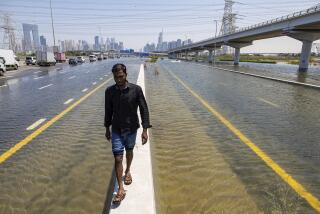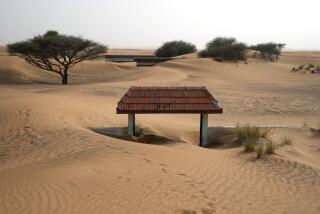Risk, opulence and reality in Dubai
Reporting from Cairo and Beirut — Dubai is a clever blend of audacity and architecture, a shiny monument to the egos and ambition that turned a tiny emirate into a Middle East financial giant. Russian oligarchs stroll along man-made islands shaped like palm trees, and sheiks race down a ski slope built inside a shopping mall.
Lacking the oil reserves of the emirate’s neighbors, Dubai’s ruling family created a parallel economic reality fueled by real estate, international investment and the art of the possible. The emirate was fashioned into a sleek cityscape of startling images: Islam balanced against the seduction of Western capitalism, and tribal traditions brushing the fleeting trends of globalization.
Cranes like countless arms moved across a skyline that grew more crowded by the day, if not the hour. The world’s tallest building went up, highways looped through the desert, the airport never closed. Dubai expanded into a commerce crossroads for Asia, Europe and America, a place of cigar salons, horse races, a seven-star hotel and suitcases full of money.
And then boom went bust.
The global recession has left Dubai with miles of office space it can’t rent and reams of contracts it can’t honor. Thousands of foreign engineers, architects, bankers and laborers have been sent home. Like everything else that has epitomized Dubai for the last decade, even its debt is staggering: An estimated $80 billion, with nearly $60 billion of it held by Dubai World, a conglomerate of a number of state-controlled businesses.
News that Dubai wanted to suspend payments on its debt shook worldwide financial markets last week. It is unclear what impact will be felt when trading opens today. Stock exchanges in Dubai and across much of the Middle East were closed Sunday during a Muslim holiday.
Dubai is one of the seven emirates that make up the United Arab Emirates, a nation wedged between the Persian Gulf and Saudi Arabia. The UAE’s Central Bank has offered emergency support to banks with holdings in Dubai. The neighboring emirate, Abu Dhabi, which has rich oil reserves, is expected to offer a limited rescue to keep the crisis contained.
“I wouldn’t expect big damage,” said Joe Kawkabani, managing director of asset management for Algebra Capital in Dubai. “The dynamics in Saudi, Qatar, Abu Dhabi are very different than the dynamics in Dubai. They have much richer economies, they have oil and sovereign wealth funds that can support them even during a recession, and they have nowhere near the amount of debt as Dubai.”
Apartment and office prices tumbled across the Emirates in 2008. An estimated 400 building and real estate projects valued at $300 billion reportedly have been put on hold throughout the country. There are fears that debt and weakened investor confidence will hit British banks, including the Royal Bank of Scotland and HSBC, which are large creditors to Dubai and the rest of the UAE.
Collapsing real estate values were not the visions of Dubai’s ruler, Sheik Mohammed ibn Rashid al Maktum, whose goal was to build an international city that would echo the grandeur of centuries past, when Baghdad and other capitals symbolized the power of the Islamic world. After Dubai emerged from British control in 1971, its ruling family quickly turned to finance, opening an airport, creating free trade zones and reaching into regional markets.
Maktum, a poet and an equestrian, was guiding much of the development before he was named ruler in 2006. His book, “My Vision,” urged other countries to follow Dubai’s success. But to his critics, including some in the Abu Dhabi royal family, Maktum was brash and reckless, overdeveloping and leveraging his emirate against the whims of global markets.
The emirate’s architecture, with buildings that billowed like sails or twirled in delicate angles, personified the rising confidence and influence of Persian Gulf nations. Dubai’s style challenged Arab world stalwarts such as Egypt and attracted a younger generation of Arab professionals from filmmakers to accountants.
“Dubai created a lot of envy in its neighbors,” said Randa Habib, a Jordanian political analyst. “Maybe the development was a bit too risky, a bit too crazy, but everyone would agree that they need the dream of Dubai to continue. It was the first Arab city that proved to the world that it could compare to a Western city with its buildings and its vision. It raised a point of pride.”
And it drew a wave of new languages. About 85% of Dubai’s population of 1.7 million are from other countries, including about 250,000 construction workers, most of them from India and elsewhere in Asia. Human rights organizations have criticized Dubai for the low wages and poor living conditions offered workers, and for turning a blind eye to prostitution networks that discreetly serve tourists, bricklayers and tycoons.
Loose oversight and light bureaucracy allowed money to flit in and out of banks and investment houses with little scrutiny. Al Qaeda and the Taliban, along with drug smugglers and gunrunners, have laundered money in Dubai’s financial institutions, according to U.S. investigators. In recent years, international pressure has forced the emirate to tighten regulations.
Dubai’s carefully calibrated cultural tolerance also is facing pressure from religious conservatives who believe it is jeopardizing its soul and traditions. This tension was highlighted in the 2008 trial of an unmarried British couple found guilty of public drinking and indecency for having sex on a beach. The case was as much about cultural boundaries as it was about the dangers of Dubai’s freewheeling capitalism.
The debt crisis has sent people scrambling, Kawkabani said.
“No one is saying it’s the end of Dubai . . . but if this is not handled properly it could be damaging to its reputation with investors and creditors,” he said.
Dubai, like General Motors, is too big not to rescue, said an editorial in the National, an Abu Dhabi newspaper.
“We should recall that it was only on June 1 that General Motors, itself once the crown jewel of American industry, sought protection from its creditors,” the newspaper said. “Many feared that the firm, whose chief executive once boasted that ‘What is good for General Motors is good for America,’ would cease making cars altogether. It emerged anew in July, streamlined and firing on all cylinders. . . . But nobody should expect a quick turnaround. Confidence is a fragile commodity.”
Lutz is a special correspondent.
More to Read
Sign up for Essential California
The most important California stories and recommendations in your inbox every morning.
You may occasionally receive promotional content from the Los Angeles Times.











